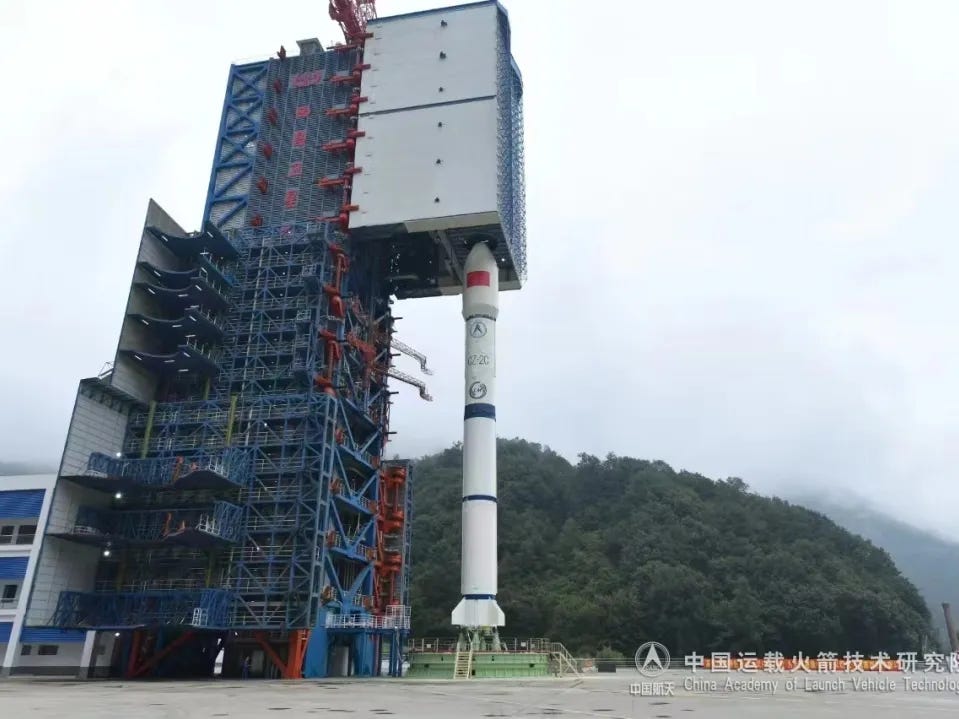How many eyes? [Long March 2C Y87]
The third group of Yaogan-43 satellites were delivered to low Earth orbit.
On October 23rd at 09:09 am China Standard Time, or 01:09 Universal Coordinated Time, a Long March 2C lifted off from Launch Complex 3 at the Xichang Satellite Launch Center and headed for low Earth orbit.
Atop of the vehicle were three Yaogan-43 satellites for Group 03 of a possible constellation. Previous Yaogan-43 launches had nine satellites carried in August followed by six in September. With three satellites onboard today's launch, eighteen Yaogan-43 satellites are now in orbit.
Official details about the Yaogan-43 satellites state that they are for testing low Earth orbit constellation technologies. The Shanghai Academy of Spaceflight Technology and the China Academy of Space Technology are believed to be involved with the constellation among others. The Shanghai Academy does state that the Yaogan-43 satellites are also for remote sensing purposes.
As remote sensing satellites, Yaogan-43 will likely provide data for land surveying, disaster prevention, and monitoring of the Earth below. Working in a constellation may also allow for frequent revisiting of a desired area as well.
Given that these satellites are under the Yaogan nomenclature, China’s military could be the satellite group’s operator and owner. As such, they may also be an equivalent of SpaceX’s Starshield constellation (Starshield is the military version of Starlink).
With one launch a month for the past three months now, the Yaogan-43 spacecraft are likely in some form of batch or mass production, allowing for low-cost high-availability imaging.
This was the 79th launch of the Long March 2C, and was the 542nd launch of the Long March launch vehicle series. Along with these, this was also the 51st launch from China in 2024.
Liftoff video via 航天五线谱 on Weibo.
As of writing (October 23rd), the Y number for this launch is believed to be Y87, this may change if clarified by the manufacturer.
Chinese companies, state-owned and private, use Y followed by a number to serialize launch mission numbering, similar to NASA with STS.
Check out the previous Yaogan-43 launches
What is the Long March 2C?
This section is for those less familiar with China's Long March series of launch vehicles.
The Long March 2C is one of the oldest launch vehicles from China performing missions regularly to low earth and sun-synchronous orbits by the China Academy of Launch Vehicle Technology. The two stages of the launch vehicle both burn Dinitrogen Tetroxide and Unsymmetrical Dimethylhydrazine.
The payload capacity of the launch vehicle is currently as follows:
3,850 kilograms to low Earth orbit
1,900 kilograms to a sun-synchronous orbit
1,250 kilograms to a geostationary transfer orbit

The first-stage is powered by four YF-21C engines, which generate 302 tons of thrust burning Dinitrogen Tetroxide and Unsymmetrical Dimethylhydrazine. The second-stage is powered by a single YF-22E engine and four YF-23C verniers that generate 80 tons of thrust while also burning Dinitrogen Tetroxide and Unsymmetrical Dimethylhydrazine.
On the launch pad, the Long March 2C is 42 meters tall and weighs 233,000 kilograms when fully fuelled. The first and second stages have a diameter of 3.35 meters, with the fairing having a diameter of either 3.35 or 4.2 meters.
So far the Long March 2C has flown from all three inland launch sites, the Jiuquan Satellite Launch Center, the Taiyuan Satellite Launch Center, and the Xichang Satellite Launch Center.






![Here comes the swarm? [Long March 4B Y72]](https://substackcdn.com/image/fetch/w_1300,h_650,c_fill,f_auto,q_auto:good,fl_progressive:steep,g_auto/https%3A%2F%2Fsubstack-post-media.s3.amazonaws.com%2Fpublic%2Fimages%2F2ae0f77a-d626-4bad-9c33-a2f9aeba5725_4524x2259.jpeg)
![Another test batch? [Long March 4B Y73]](https://substackcdn.com/image/fetch/w_1300,h_650,c_fill,f_auto,q_auto:good,fl_progressive:steep,g_auto/https%3A%2F%2Fsubstack-post-media.s3.amazonaws.com%2Fpublic%2Fimages%2F9bdfe5cb-063b-48f6-a19b-ce805c08347e_2217x1299.jpeg)